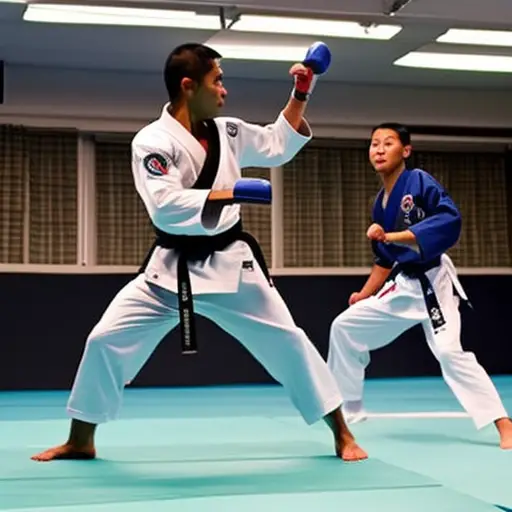Speed and Power Drills for Taekwondo Athletes

In the world of taekwondo, speed and power are essential attributes that separate the average athlete from the exceptional. To cultivate these qualities, taekwondo athletes turn to a set of specialized drills designed to enhance their performance.
From plyometric exercises that ignite explosive power to agility drills that sharpen footwork, this article explores a range of training techniques.
In addition, resistance training for increased strength and speed training drills for faster strikes are covered, alongside power kicking drills for maximum impact.
Plyometric Drills for Explosive Power
To enhance explosive power, incorporate plyometric drills into your training routine. Plyometric drills are a form of exercise that focuses on rapid and powerful movements, utilizing the stretch-shortening cycle of the muscles. These drills are especially beneficial for taekwondo athletes who require explosive power for various techniques such as kicks and jumps.
Jumping exercises are an essential component of plyometric training. Box jumps, in particular, are an effective plyometric exercise for developing explosive power. To perform box jumps, start by standing in front of a sturdy box or platform. Bend your knees and swing your arms back, then explosively jump onto the box, extending your hips and knees fully. Land softly, absorbing the impact with your legs, and then step down or jump down from the box. Repeat this movement for a desired number of repetitions.
Box jumps engage the muscles of the lower body, including the calves, quadriceps, hamstrings, and glutes. They improve muscular power, coordination, and balance. Additionally, box jumps help to strengthen the tendons and ligaments, which can reduce the risk of injuries during explosive movements.
Incorporating box jumps into your training routine can lead to significant improvements in explosive power, allowing you to execute powerful kicks and jumps with greater speed and force. It is important to start with a lower box height and gradually increase the challenge as your strength and power improve. Always prioritize proper form and technique to maximize the benefits of plyometric training.
Agility Drills for Quick Footwork
Agility drills are essential for taekwondo athletes to develop quick footwork and enhance their ability to maneuver swiftly and efficiently in various directions. These drills focus on lateral movement exercises and reaction time drills to improve the athlete’s agility and responsiveness during matches.
Lateral movement exercises play a crucial role in developing the athlete’s ability to move quickly and smoothly from side to side. One common drill is the lateral shuffle, where the athlete moves laterally in a controlled manner, maintaining a low stance and quick, short steps. This drill helps improve balance, coordination, and speed, enabling the athlete to evade opponents’ attacks effectively.
Another important aspect of agility training is reaction time drills. These drills simulate real-time situations where the athlete must quickly react to an opponent’s movement or attack. One popular drill is the cone drill, where cones are placed in a random pattern, and the athlete must react and move to touch each cone as fast as possible. This drill improves the athlete’s reflexes, agility, and decision-making skills.
Agility drills should be incorporated into the training regimen of taekwondo athletes regularly. By focusing on lateral movement exercises and reaction time drills, athletes can enhance their footwork, speed, and ability to quickly change direction. These skills are crucial in taekwondo, where agility and quick footwork can make a significant difference in the outcome of a match.
Resistance Training for Increased Strength
The incorporation of resistance training into a taekwondo athlete’s regimen can lead to increased strength and power. Resistance training involves the use of external forces, such as resistance bands or weights, to challenge the muscles and stimulate growth. By incorporating resistance training into their routine, taekwondo athletes can enhance their performance and excel in their sport.
One effective tool for resistance training is the use of resistance bands. These bands provide constant tension throughout the movement, engaging the muscles in a different way than traditional weightlifting techniques. They can be used to target specific muscle groups, such as the legs for kicking power or the arms for punching strength. Additionally, resistance bands allow for a wide range of exercises that can be tailored to each athlete’s specific needs and goals.
Weightlifting techniques, such as squats, deadlifts, and bench presses, are also beneficial for taekwondo athletes. These compound exercises work multiple muscle groups simultaneously, improving overall strength and power. When done correctly and with proper form, weightlifting can help athletes develop explosive movements and generate more force in their kicks and punches.
Incorporating resistance training into a taekwondo athlete’s regimen can lead to significant improvements in strength and power. By utilizing resistance bands and weightlifting techniques, athletes can enhance their performance and take their skills to the next level.
| Resistance Bands | Weightlifting Techniques |
|---|---|
| Constant tension | Engage multiple muscles |
| Target specific muscle groups | Enhance overall strength |
| Wide range of exercises | Improve explosive movements |
Speed Training Drills for Faster Strikes
Significantly improving striking speed is crucial for taekwondo athletes looking to enhance their performance in the ring. To achieve faster strikes, taekwondo athletes can incorporate specific speed training drills into their training regimen. These drills focus on enhancing reaction time and building endurance for sustained speed performance.
Here are some effective techniques:
-
Reaction time exercises for lightning-fast reflexes:
-
Shadowboxing: Practicing strikes in front of a mirror or imaginary opponent helps improve reaction time by allowing athletes to visualize and anticipate movements.
-
Partner drills: Engaging in partner drills, such as pad work or sparring, helps athletes develop quick reflexes by forcing them to react swiftly to their partner’s movements.
-
Agility ladder drills: Performing footwork drills using an agility ladder enhances speed and coordination, improving reaction time during strikes.
-
Target practice: Using reaction balls or targets that require quick strikes helps athletes develop faster reflexes and hand-eye coordination.
-
Endurance training techniques for sustained speed performance:
-
High-intensity interval training (HIIT): Incorporating HIIT workouts into training sessions helps improve cardiovascular endurance, allowing athletes to maintain high-speed performance for longer durations.
-
Circuit training: Engaging in a variety of exercises with minimal rest periods helps taekwondo athletes build muscular endurance, enabling them to maintain speed throughout a fight.
-
Plyometric exercises: Including explosive movements, such as box jumps or medicine ball throws, in training routines helps develop fast-twitch muscle fibers, essential for quick strikes.
-
Skipping rope: Regularly skipping rope improves footwork speed and endurance, translating to faster strikes in the ring.
Power Kicking Drills for Maximum Impact
To achieve maximum impact with their kicks, taekwondo athletes can incorporate power kicking drills that focus on developing strength and technique. These drills aim to enhance the power behind each kick, allowing athletes to deliver precise and forceful strikes during competitions or self-defense situations.
Precision techniques are crucial for accurate kicks that can effectively hit the target. Athletes can practice precision by focusing on the correct body alignment, balance, and timing of their kicks. By repeatedly performing kicks with proper form and targeting specific areas, taekwondo athletes can improve their accuracy and increase the impact of their strikes.
In addition to precision, flexibility plays an essential role in achieving maximum power in kicks. Flexibility exercises enable athletes to improve their range of motion, allowing them to generate more speed and force in their kicks. Stretching exercises that target the legs, hips, and lower back can help increase the flexibility required for powerful kicks.
To enhance power in their kicks, athletes can also incorporate strength training exercises into their training routine. These exercises may include squats, lunges, and plyometric exercises that focus on explosive power. By developing strength in the muscles used for kicking, taekwondo athletes can generate greater force and impact in their strikes.
Frequently Asked Questions
How Many Times a Week Should I Incorporate Plyometric Drills Into My Training Routine?
Incorporating plyometric drills into a training routine can enhance athletic performance. The frequency of plyometric training depends on individual factors such as fitness level, training goals, and recovery ability. Consulting with a qualified trainer can help determine the optimal frequency for maximum benefits.
Are There Any Specific Agility Drills That Can Help Improve My Balance and Coordination?
Balance and coordination drills play a crucial role in enhancing the performance of Taekwondo athletes. Agility ladder exercises, which involve precise footwork and quick changes in direction, can significantly improve agility, balance, and coordination, leading to enhanced athletic performance.
What Types of Resistance Training Exercises Are Most Effective for Taekwondo Athletes?
Plyometric exercises, a form of plyometric training, are highly effective for taekwondo athletes. These exercises involve rapid stretching and contracting of muscles, improving explosive power and speed. Incorporating plyometrics into a training regimen can greatly enhance performance in taekwondo.
How Often Should I Include Speed Training Drills in My Taekwondo Workout?
The frequency of speed training drills in a taekwondo workout depends on various factors such as the athlete’s goals, training level, and overall program design. Incorporating the best speed training techniques can enhance performance and improve reaction time and explosive power.
Are There Any Recommended Power Kicking Drills That Can Help Me Increase the Force and Impact of My Kicks?
To increase the force and impact of your kicks in Taekwondo, incorporating power kicking techniques and plyometric training can be highly beneficial. These drills focus on developing explosive power and improving overall kicking performance.
Conclusion
To become a formidable force in the world of taekwondo, athletes must engage in a variety of speed and power drills.
Plyometric exercises enhance explosive power, while agility drills improve footwork.
Resistance training builds strength, and speed training drills enable faster strikes.
Lastly, power kicking drills are essential for delivering maximum impact.
By incorporating these drills into their training regimen, taekwondo athletes can elevate their skills to new heights and dominate the competition.





